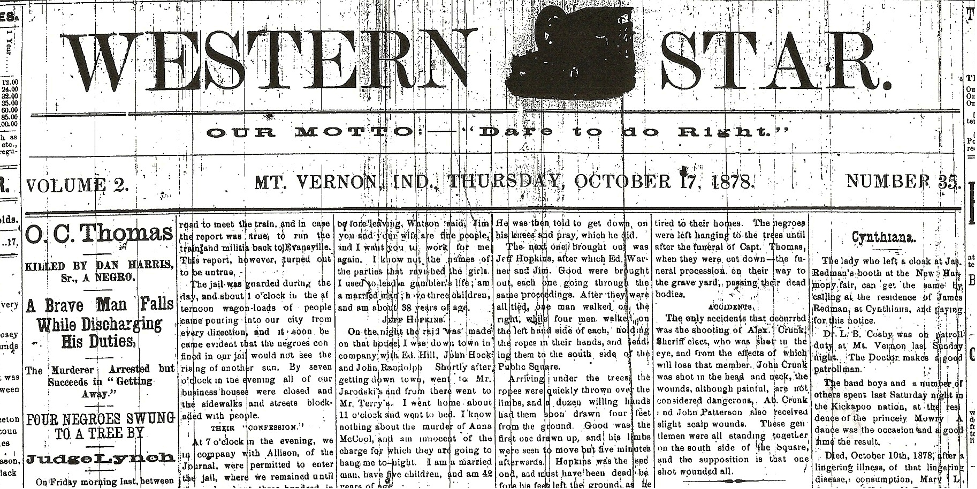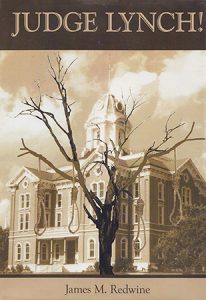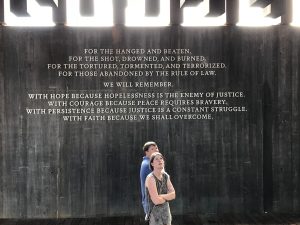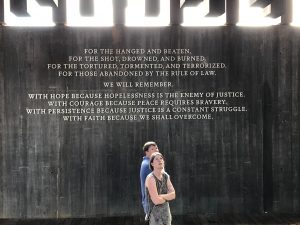
Since 1990 when German born American Ilse nee Dorsch Horachek made me aware of the tragedy of 1878, my wife Peg and I have researched, spoken, written and helped produce a short movie about those events. And in our historical novel, JUDGE LYNCH!, that we published in 2008 we called for a public monument to the victims to be erected on the southeast corner of the Posey County Courthouse campus where the bones of Daniel Harrison, Sr. may still be buried. Our principal focus has always been the injustice done to the victims and the shameful failings of our legal system. Finally, thanks mainly to teenager Sophie Kloppenburg with input from numerous others a memorial marker to the victims was erected on the campus of the Posey County Circuit Courthouse October 23, 2022. Sophie also organized a one-year commemoration that was held October 21, 2023 and asked Peg and me to participate. The following is the eulogy to the victims that was published in Gavel Gamut after the monument was dedicated in 2022.
EULOGY FOR THE VICTIMS OF OCTOBER 1878
BY
JUDGE JIM REDWINE
FIRST PUBLISHED THE WEEK OF OCTOBER 23, 2022
ACCORDING TO JOSEPH CAMPBELL, TO BE UNAWARE IS THE ULTIMATE SIN. FROM THE AUTUMN OF 1878 UNTIL TODAY, OCTOBER 23, 2022, IN SPITE OF NUMEROUS EFFORTS TO BRING THE CARNAGE TO LIGHT, MOST OF POSEY COUNTY, INDIANA STAYED WILLINGLY UNAWARE OF THE MEMORY OF THE SLAUGHTER OF DANIEL HARRISON, SR., THE BURNING ALIVE OF DANIEL HARRISON, JR., THE SHOOTING OF JOHN HARRISON, THE LYNCHING ON THE COURTHOUSE CAMPUS OF JIM GOOD, WILLIAM CHAMBERS, EDWARD WARNER AND JEFF HOPKINS AND THE POGROM THAT CAUSED ONE-HALF OF THE REMAINING NEGRO RESIDENTS OF POSEY COUNTY, INDIANA TO FLEE FOR THEIR LIVES.
THIS MEMORIAL RESTS WHERE LOCUST TREES ONCE BORE THE STRANGE BLACK FRUIT WITH ELONGATED TONGUES, BULGING EYES AND NUMEROUS BULLET HOLES FROM THE GUNS OF WHITE CITIZENS WHO USED THE BODIES FOR TARGET PRACTICE.
FINALLY, WE CAN DEDICATE CONCRETE ACKNOWLEDGEMENT OF THE WHITE CITIZENS’ ORCHESTRATED AND DISCIPLINED CAMPAIGN OF TERROR AGAINST THE BLACK COMMUNITY AND THE SHAMEFUL COWARDICE OF THE LEGAL SYSTEM AND THE NEWS MEDIA TO NOT ONLY CONDONE THE TERRORISM, BUT TO ACTIVELY HELP HIDE IT FROM HISTORY.
WE DO NOT CELEBRATE TODAY AND WE CANNOT ATONE FOR YESTERDAY. WE CAN, AND DO, ACKNOWLEDGE WRONGS LONG IGNORED AS WE GATHER ABOVE WHERE THE BONES OF DANIEL HARRISON, SR., MAY STILL LIE MOLDERING, AND WE CAN AND DO SAY TO ALL THOSE VICTIMS FROM OCTOBER, 1878, WE AS A COMMUNITY, FINALLY, ARE PUBLICLY AWARE.



